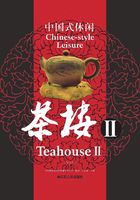
茗古园茶艺会馆
Ming Gu Yuan Tea Club

设计师:陈杰
设计单位:福州大木和石设计联合会馆
项目地点:中国福州
建筑面积:130平方米
主要材料:轻质隔墙、麻布、炭化木、大理石火烧、磨纱玻璃、发剂
The design concept of this project originated from the "purity" principle of the essence of sado, "harmony, respect, purity, peace". The space represents a realm of self-cultivation that "people become pure when there are no chaos in their heart". In creating such an atmosphere, the designer hopes through communication with the space, the visitors could feel the peaceful self after putting down the desires and distracting thoughts, to comprehend the focused, restrained tea realm that is perfectly pure.
Based on the understanding of "everything is nothing", the design adopts neo-oriental style, which is moderate and simple, to create a time-space-frozen plane world with only two vectors. It symbolizes clear mind and a return to nature and simplicity.
Ming Gu Yuan Tea Club learned from the Japanese dry landscape, and presented the nature of things to return to tranquility and simplicity after prosperity. The tea club looks like an antique temple, which is peaceful and comfortable. The decoration materials are simple materials like raw wood and stone. The designer confidently adopted natural linen as wall decoration material, whose natural and appropriate texture creates an environment rich in culture. The space is decorated with cloud-shaped lights set which responds to the theme of the space.







The partitions of the space are hollow walls, which divide the space into a structure of two passages and three spaces. Entering in the first passage and space, you will see the backdrop of painting "infinite love", in which a person sat alone by the window under the moon and watched things prosper and die in the small space, which reveals purity and peace of sado. In the second passage and space, the window extended from the little tea room is an interpretation of ancient writing of "to avoid" and sado's "respect".
To avoid is to say "do not do the things to others that you would not like to be done to you". The space is comfortable and becomes a small world in its own way. Entering in the second passage and the third space, which is the hall of Ming Gu Yuan, you will see a long table connecting the space together, which shows integration and inclusion, and "harmony" of sado. The spaces interpret the essence of sado through the spatial relations.
茗古园的设计理念源于茶道“和、敬、清、寂”四字真髓中的“清”字,演绎“心无旁物人自清”的修养境界,希望宾客通过与空间的交流,感受放下欲望,心无杂念的平静本我之态,领悟专注、克制的至清茶境。
思路演化为“神马都是浮云”的世事理解,利用新东方风格的内敛与简洁,力图以形化境,创造一个在时间和空间上都暂时凝固了的,仅有两个向量的平面世界。它是清明心智的象征,表现摈弃繁华,达成自然质朴的本心回归,以古为茗、以茗博古。
茗古园借鉴日式枯山水的手法,展现繁华过后平静质朴的世事本质,古庙静堂,自在宁静。装饰材料应用原木、原石等质朴素材。在墙面装饰上大胆使用天然麻布装裱,贴近自然而恰如其分的斑驳营造了浓郁的人文环境。空间点缀浮云状照明灯套呼应主题。空间通过镂空墙体分割,从形式上拆解为二进三方结构。一进一方,入户布景“大爱”,窗如明月人独坐,一方天地一枯荣,体现茶道的“清”、“寂”;二进二方,小茶室延伸的橱窗以对古文字“勿”的理解,领悟茶道的“敬”,以“勿”通戒,己所不欲勿施于人,宽容自在、自成天地;二进三方,茗古园大堂以长桌聚四方,融合、包容,尽显茶道“和”境。空间文化关系层层解析茶道真髓。
